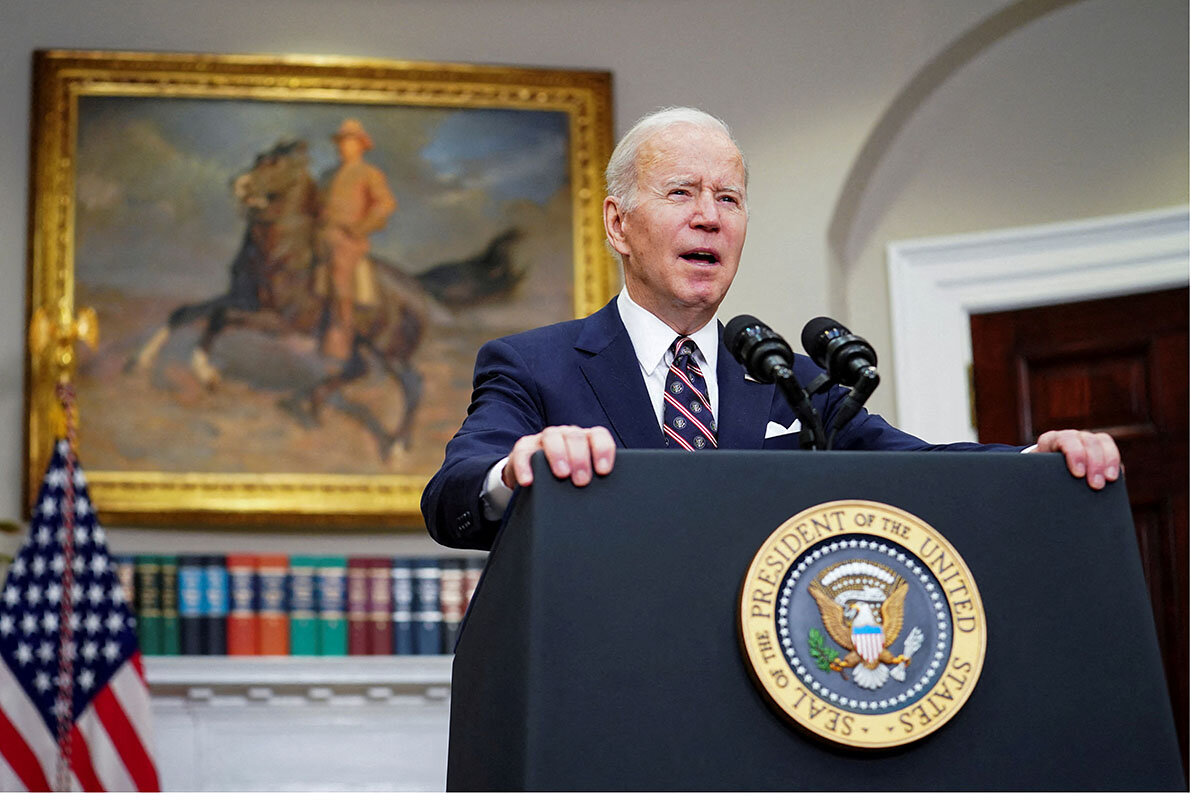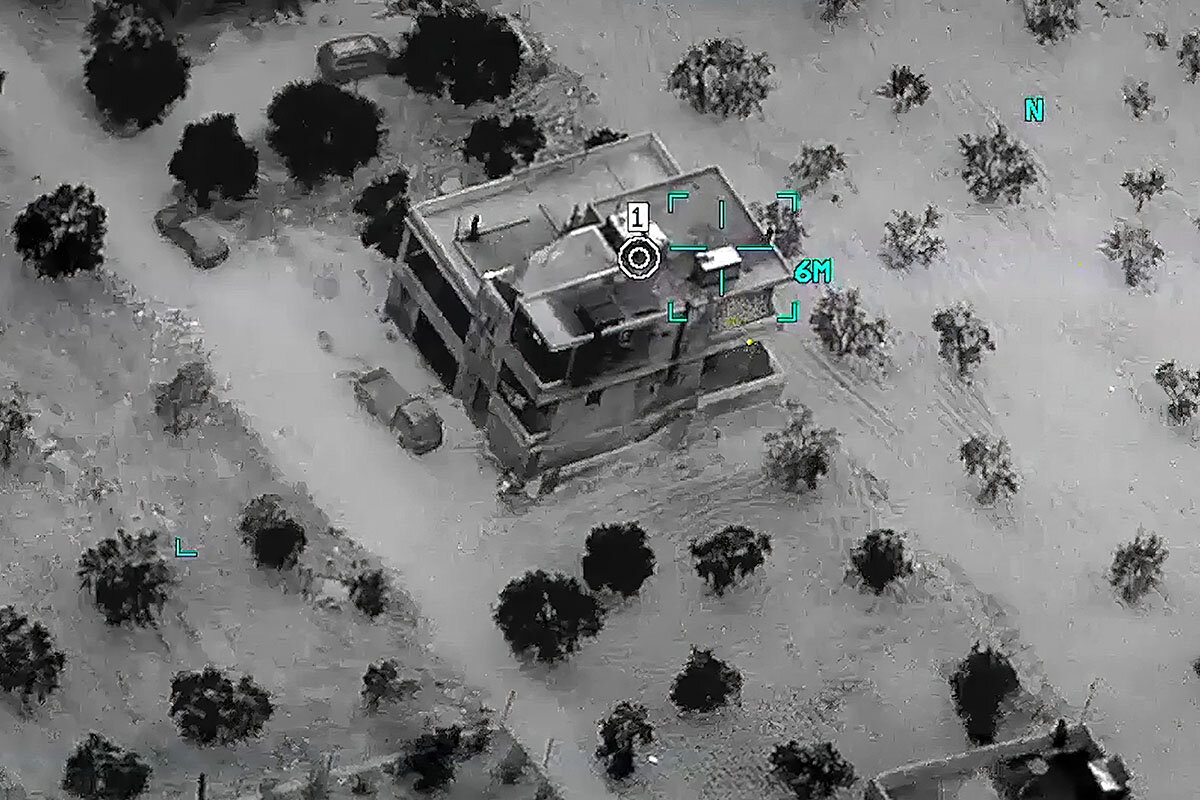As US battles ISIS, many in Syria take their cue from Afghanistan
Loading...
| AMMAN, Jordan
The Biden administration touted the high-profile U.S. raid that led to the death of ISIS leader Abu Ibrahim al-Hashimi al-Qurayshi in northern Syria last week as sending “a strong message to terrorists around the world.” But for many outside Syria, it was a rare reminder that the fight against the Islamic State was, in fact, not over.
Three years after its territorial defeat, with the fall of its self-declared caliphate, ISIS has evolved from a military group into a decentralized insurgency operating on the fringes of Syria and Iraq. That has left the U.S.-led, global anti-ISIS coalition and its local partners adapting – often on the fly – to pursue a mission with no end date in sight.
“No one quite wants to acknowledge that the fight against ISIS in Iraq and in Syria in particular just isn’t finished yet,” says Charles Lister, director of the Middle East Institute’s Syria and Countering Terrorism & Extremism programs.
Why We Wrote This
Perceptions of weakness can be hard to dispel. If the U.S. sought to signal resolve with its anti-ISIS raid in Syria, it is still battling the legacy of its withdrawal from Afghanistan.
“The killing of Qurayshi might have lulled people into a sense of security that everything is under control and that the campaign is moving in the right direction, but that would be misplaced.”
Despite the United States declaring victory after the fall of the “caliphate” in northern Syria in 2019, ISIS retains a presence in eastern Syria and western Iraq. Its affiliates, meanwhile, also are carrying out devastating attacks in Taliban-led Afghanistan, and they control territory in West Africa, in Nigeria and Mali.
It might be a far cry from the organization that ran a Britain-sized “state” in Syria and Iraq from 2014-18, but experts and military officials say ISIS is now a cost-effective, off-the-radar movement quietly rebuilding its manpower and financial resources in the shadows, willing to strike when the right opportunity arises.
One such opportunity arose in late January when ISIS forces attacked the al-Sinaa prison in Hassakeh, in northeastern Syria, a makeshift detention facility where predominately Kurdish forces were holding some 4,000 ISIS fighters at the behest of the U.S.-led coalition.
After a weeklong operation, the Syrian Democratic Forces (SDF) repelled the ISIS siege, thanks to the intervention of U.S. Special Operations forces. Around 300 ISIS fighters are estimated to have escaped.
Afghanistan’s shadow
The Biden administration highlighted last Thursday’s raid against Mr. Qurayshi as a decisive response to the prison break. But for local Syrians trying to navigate between the Western-backed SDF and the persistent, largely homegrown ISIS insurgency, the raid was not sufficient to alleviate their doubts about the global coalition: whether it can sustain anti-ISIS operations while countries turn their attentions elsewhere and cut back their resources and presence on the ground.
In particular, the shadow of Afghanistan and the question of American dependability loom large in Syria, making U.S. support the SDF’s Achilles’ heel.
In the wake of the chaotic U.S. withdrawal from Afghanistan last summer, analysts say, Syrians became convinced Americans will leave Syria suddenly, without warning, and that therefore the SDF is an entity facing an inevitable collapse.
“Should the Americans move to withdraw from Syria, the SDF will collapse quicker than the Ashraf Ghani government in Afghanistan, and ISIS will be ready,” says Hasssan Abu Haniya, a Jordanian expert on jihadist movements.
With this in mind, and in order to live another day, many local communities in eastern Syria are pursuing a strategy of lying low and acquiescing to extortionist ISIS demands for so-called protection money, rather than cooperate with the SDF.
“People in eastern Syria fear collective punishment, and they don’t want to jeopardize themselves by cooperating on counter-ISIS raids with an SDF many see as a fleeting entity,” says Dareen Khalifa, senior Syria analyst for the International Crisis Group.
“They are worried [that] if they cooperate and the SDF withdraws or the Americans leave, either the Assad regime will retaliate against them or ISIS will retaliate. We are seeing people in eastern Syria hedging their bets, and this offers leeway for ISIS to operate in these areas.”
U.S. deployment
There are currently 700 U.S. troops in northeast Syria and 200 in southeast Syria near the Syrian-Jordanian border, the Pentagon said last October, down from a publicly disclosed high of 2,000 in 2018. There is also a small contingent of British special forces.
Since ISIS’s territorial defeat, the Americans and British have supported the SDF and are widely seen by analysts and policymakers as a low-cost, minimal military footprint that has prevented power vacuums and conflicts that could facilitate the terror group’s resurgence.
The military campaign to oust ISIS from towns and villages in 2014-19 required international manpower and investment, but was a straightforward military operation with clear objectives.
“But in this new environment the enemy is hidden, the objectives are completely gray, so in that sense, can we rely so heavily on a poorly resourced actor like the SDF for intelligence gathering and strategic planning with minimal assistance from international forces?” Mr. Lister says.
And as for the death of Mr. Qurayshi, analysts say it was an important setback, but by no means a game changer.
Much like in 2010, when what was then known as Al Qaeda in Iraq was driven into the desert by U.S.-supported Sunni tribesmen, ISIS is capable of producing new leaders while maintaining its loosely connected, localized networks intact, like a self-regenerating terrorist hydra.
“In the past we saw the assassination of Zarqawi, Baghdadi, and now” Mr. Qurayshi, “and each time other people stepped in to lead this movement into a new era,” says Mr. Abu Haniya, the Jordanian analyst.
“The assassination of leadership figures will not affect ISIS’s activities in West Africa, Afghanistan, or even Syria. In its current form, this is a decentralized movement; you can keep cutting off the head and the body will keep on living.”
As part of its evolving mission, the global coalition has also sought to tackle the Islamic State’s “financing and economic infrastructure.”
It has proved a difficult task.
According to experts, when it retreated underground, ISIS had between $150 million and $300 million in reserves, which it allegedly has invested in small and medium economic enterprises through intermediaries.
Among its reported investments are small commercial outlets and shops in eastern Syria and western Iraq handling a large number of small cash transactions not easily tracked by the global coalition.
Another revenue stream is believed to be its extortion racket, demanding money and taxes from businesses and communities in eastern Syria and western Iraq for “protection” from violence, and from truck drivers for safe passage.
“For these jihadist groups, the desert borders are like the sea, and they are the captains of these ships; they know how to navigate them much better than the forces that are protecting them,” says Rasha Al Aqeedi, senior analyst at the New Lines Institute for Strategy and Policy, a Washington think tank.
SDF weaknesses
Perhaps the most critical part of the fight against ISIS has been the U.S.-led coalition’s local partners.
The SDF, a multiethnic coalition of Kurdish, Christian, and Arab fighters formed in 2015 with U.S. support, today polices and administers former ISIS-held lands in Syria including Raqqa, Deir ez-Zour, and Hassakeh, in territory encompassing Syria’s oil- and gas-rich areas.
Yet in recent years, as the economic and humanitarian situation in northern and eastern Syria worsened, attitudes toward the SDF have soured.
Its own employees have expressed resentment over the Kurdish PKK’s dominance of leadership positions and resources within the SDF, accusing it of discrimination. Sporadic, violent local protests have erupted against its rule in the past year.
And as the SDF branched out to control more territory, it has found itself administering Arab communities in which it is a stranger, finding itself unable to perform wide counterterrorism sweeps or intelligence operations.
It also remains entirely reliant on the presence of U.S. troops near Hassakeh. The SDF needs the Hassakeh region’s natural resources such as oil, gas, and wheat as a revenue stream to pay its troops and Arab and Kurdish employees.
Observers caution that although ISIS is not set to reemerge like 2014, it will continue opportunistic attacks as it regroups, though at a level unlikely to trigger enhanced international support for the SDF.
“These attacks may continue to happen, but unfortunately they are not big enough for the global coalition to take extra steps,” Ms. Al Aqeedi says, “and Iraq and Syrian security personnel and civilians are the victims.”








